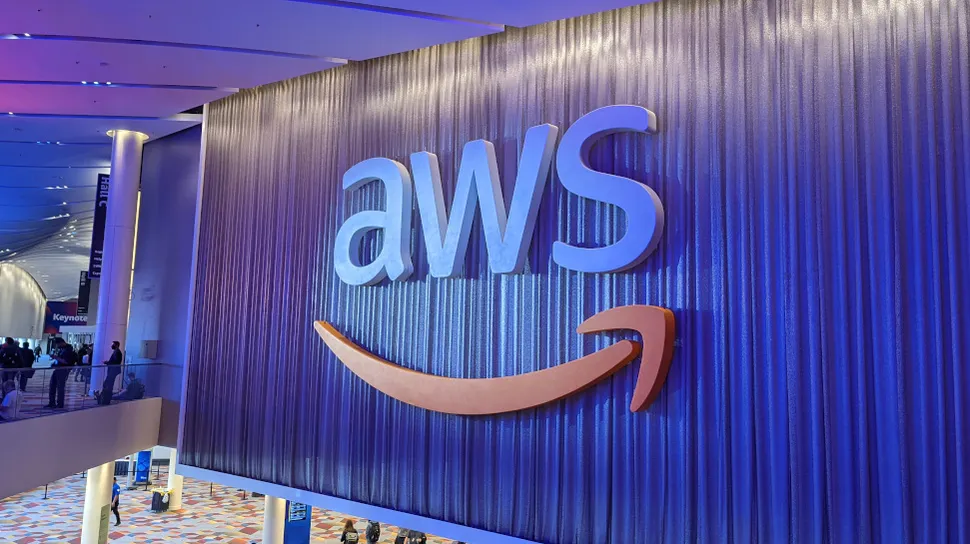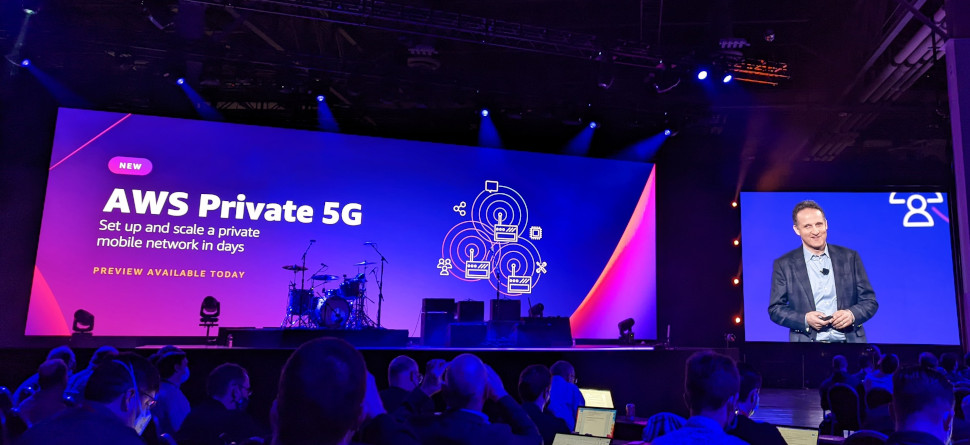Private 5G
“There’s nothing like it;” AWS CEO announces Private 5G at AWS re-Invent 2021; Dish Network’s endorsement
Amazon Web Services (AWS) CEO Adam Selipsky kicked off day 2 of AWS re-Invent 2021 today with a keynote presentation loaded with exciting announcements, status updates, and long-term vision-setting for the AWS cloud platform. AWS is now in its 15th year. It currently has 81 Availability Zones, 250+ services, 475 instance types to support virtually any workload. And it has an always-evolving library of solutions designed for highly specific use cases.
The AWS cloud stores more than 3 trillion objects, AWS offers over 200 fully-featured services, with millions of customers around the world,” the CEO said. Of those customers, Netflix, NASA and NTT DoCoMo are highlighted as some of the most innovative use cases for AWS.
“In the last 15 years, cloud has become not just another tech revolution, but a shift in how businesses actually function. There’s no business that can’t be radically disrupted. And we’re just getting started,” Selipsky added, noting that only 5-15% of spending has moved to the cloud, so there’s a big opportunity to come, with 5G and IoT becoming super important too.
“We’re going to keep innovating to keep offering the broadest suite of services,” Selipsky said.

The most import announcement for IEEE Techblog readers was a new AWS Private 5G service that will allow users to launch and manage their own private mobile network in days with automatic configuration, no per-device charges, and shared spectrum operation. AWS provides all the hardware, software, and SIMs needed for Private 5G, making it a one-stop solution that is the first of its kind.
“It’s not easy to set up a private 5G network using offerings from existing 5G providers, according to AWS CEO. “Currently, private mobile network deployments require customers to invest considerable time, money and effort to design their network for anticipated peak capacity, and procure and integrate software and hardware components from multiple vendors. Even if customers are able to get the network running, current private mobile network pricing models charge for each connected device and make it cost prohibitive for use cases that involve thousands of connected devices.”
Selipsky said AWS customers will be able to select where they want to build a mobile network and the network capacity they need. AWS will then deliver and maintain the network’s necessary small cell radio units, servers, 5G core and radio access network (RAN) software, and subscriber identity modules (SIM cards) required for a private 5G network and its connected devices.
“AWS Private 5G automates the setup and deployment of the network and scales capacity on demand to support additional devices and increased network traffic,” the company explained, noting the network will work in “shared spectrum,” likely a reference to the 3.5GHz CBRS spectrum band in the U.S. “There are no upfront fees or per-device costs with AWS Private 5G, and customers pay only for the network capacity and throughput they request.”
“It’s (AWS Private 5G) shockingly easy,” according to Selipsky – AWS sends everything you need, from hardware to software to SIM cards. Automatic configuration makes it ideal for factories and workplaces, and you can ask for as many devices to be connected as you need. He added that the company will sell the service under a pay-as-you-go model, and won’t add any per-device fees. “There’s nothing like AWS Private 5G network out there,” the CEO concluded.
“Many of our customers want to leverage the power of 5G to establish their own private networks on premises, but they tell us that the current approaches make it time-consuming, difficult, and expensive to set up and deploy private networks,” said David Brown, Vice President, EC2 at AWS in a press release. “With AWS Private 5G, we’re extending hybrid infrastructure to customers’ 5G networks to make it simple, quick, and inexpensive to set up a private 5G network. Customers can start small and scale on-demand, pay as they go, and monitor and manage their network from the AWS console.”
Dell’Oro Group’s VP Dave Bolan wrote in an email, “What is new about this announcement, is that we have a new Private Wireless Network vendor (AWS) with very deep pockets that could become a major force in this market segment.”

Immediately after Selipsky keynote speech, Dish Network’s Chief Network Officer Marc Rouanne took the re-Invent stage to tout his own company’s forthcoming 5G network. [Note that AWS is providing the 5G SA cloud native core network for Dish]. Rouanne, touted the appeal of Dish’s planned (but delayed) 5G network for enterprise customers. He said Dish is building a “network of networks” that enterprise customers will be able to adapt to their needs. He said Dish’s 5G customers will be able to customize their services based on parameters such as speed and latency, but didn’t mention that’s based on network slicing which requires the 5G SA core network that Dish has outsourced to AWS.
“Some say we are the AWS of wireless,” Rouanne said, adding that Dish’s 5G will be as flexible as the cloud computing service built by Amazon. “Dish is going to be the enabler of technology that people have not even imagined yet.”
“We’re building the first architecture that is truly optimized for the cloud. It promises tremendous advances, not just for human communications, but also for machine to machine, and of course for humans to control those machines,” he added.
We have previously expressed skepticism that Dish can be an effective telecom/IT systems integrator with no experience whatsoever in that field. We wrote:
Dish said it would use Cisco for routing, IBM for automation, Spirent for testing and Equinix for interconnections – announcements noteworthy considering Dish is mere weeks from its first market launch. The ability to automatically, virtually and in parallel test new 5G Standalone services, slices and software updates in the cloud is key to Dish Network’s network strategy and its differentiation, according to Marc Rouanne, Dish EVP and chief network officer for its wireless business. Rouanne said that the ability to rapidly test and certify network software and services has been part of Dish’s vision for its network. Dish announced more than a year ago that it would use radio management software from both Mavenir and Altiostar, when Rakuten was a major investor in Altiostar (it now owns that company).
–>So it seams that Dish Network’s 5G role will be that of a systems integrator, putting together the many outsourced parts of its 5G greenfield network. It remains to be seen what combination of vendors will supply the Open RAN portion of the 5G network and what development, if any, Dish’s engineers will do for it. And how will Dish’s 5G SA core network via AWS interface with those Open RAN vendors?
In the previously referenced press release from AWS, Stephen Bye, Chief Commercial Officer, DISH said, “Selecting AWS has enabled us to onboard and scale our 5G core network functions within the cloud. They are a key strategic partner in helping us deliver private enterprise networks to our customers. AWS’s innovative platform allows us to better serve our consumer wireless customers, while unlocking new business models for enterprise customers across a wide range of industry verticals. Our ability to support dedicated, private 5G enterprise networks allows us to give customers the scale, resilience and security needed to support a wide variety of devices and services, unlocking the potential of Industry 4.0.”
In conclusion, it looks like the AWS Private 5G network (where Amazon provides the 5G RAN and 5G core) will compete with Dish’s 5G network (where Dish provides the RAN while AWS provides the 5G SA core network) for industrial customers. In that sense, it is a win-win proposition for Amazon as AWS will be competing with AWS (hah, hah!) for the 5G SA core network. It’s also significant that these announcements strengthened the trend to use 5G for industry/factory applications rather than for consumers where there is little or no benefits.
All in all, it send a strong competitive signal to wireless telcos that they’ll be competing with cloud hyperscalers as well as network equipment and software companies in the 5G private network market.
About Amazon Web Services:
For over 15 years, Amazon Web Services has been the world’s most comprehensive and broadly adopted cloud offering. AWS has been continually expanding its services to support virtually any cloud workload, and it now has more than 200 fully featured services for compute, storage, databases, networking, analytics, machine learning and artificial intelligence (AI), Internet of Things (IoT), mobile, security, hybrid, virtual and augmented reality (VR and AR), media, and application development, deployment, and management from 81 Availability Zones (AZs) within 25 geographic regions, with announced plans for 27 more Availability Zones and nine more AWS Regions in Australia, Canada, India, Indonesia, Israel, New Zealand, Spain, Switzerland, and the United Arab Emirates. Millions of customers—including the fastest-growing startups, largest enterprises, and leading government agencies—trust AWS to power their infrastructure, become more agile, and lower costs. To learn more about AWS, visit aws.amazon.com.
References:
https://reinvent.awsevents.com/
https://press.aboutamazon.com/news-releases/news-release-details/aws-announces-aws-private-5g
https://www.techradar.com/news/live/aws-reinvent-2021-keynote-live-blog
https://www.lightreading.com/open-ran/amazon-dish-peddle-dueling-5g-products/d/d-id/773802?
Analysis of Dish Network – AWS partnership to build 5G Open RAN cloud native network


